Tirzepatide for Sleep Apnea - Can It Help?
Understanding Sleep Apnea and Its ChallengesSleep apnea is a common yet serious sleep disorder characterized by repeated interruptions in breathing during sleep. These pauses [...]
Read More
Medically reviewed by Abhijit Bhattacharyya | MD, PhD, MBA, Tufts University School of Medicine - Miami, Florida on March 8th, 2024.
Tooth decay is a common dental problem that affects people of all ages. It occurs when bacteria in your mouth feed on sugars and starches from the foods you eat, producing acid that erodes your tooth enamel. Over time, this can lead to the formation of cavities, which are small holes in your teeth. If left untreated, tooth decay can cause pain, infection, and even tooth loss.
Tooth decay is caused by a combination of factors, including:
Poor oral hygiene habits, such as not brushing or flossing regularly
Consuming sugary or starchy foods and drinks, which feed the bacteria in your mouth
Not getting enough fluoride, which helps strengthen your tooth enamel
Having a dry mouth, which can be caused by certain medications or medical conditions
The good news is that tooth decay is largely preventable. Here are some steps you can take to keep your teeth healthy and strong:
Brush your teeth at least twice a day with a fluoride toothpaste, especially after meals and before bed.
Floss daily to remove plaque and food particles from between your teeth.
Use a fluoride mouthwash to help strengthen your tooth enamel and kill bacteria.
Eat a balanced diet and limit your intake of sugary and starchy foods.
Visit your dentist regularly for professional cleanings and checkups.
In addition to these basic steps, there are some other things you can do to prevent tooth decay:
Ask your dentist about dental sealants, which are a protective coating applied to the chewing surfaces of your back teeth.
Drink fluoridated water, which helps strengthen your teeth from the inside out.
Chew sugar-free gum containing xylitol, which can help reduce the risk of tooth decay.

If you do develop tooth decay, there are several treatment options available, depending on the severity of the decay:
Fluoride treatments: If the decay is caught early, a fluoride treatment may be able to reverse it.
Fillings: If the decay has progressed to the point of forming a cavity, your dentist may need to remove the decayed material and fill the cavity with a tooth-colored filling.
Crowns: If the decay is extensive, your dentist may need to place a crown over the affected tooth to restore its shape and function.
Root canal: If the decay has reached the pulp of the tooth, a root canal may be necessary to remove the infected tissue and save the tooth.
Researchers are also exploring new ways to prevent and treat tooth decay, such as:
Toothpastes and mouthwashes that can reverse early cavities
Materials that slowly release fluoride over time to help prevent further decay
Chewing gum containing xylitol, which can help reduce the risk of tooth decay
By understanding the causes of tooth decay and taking steps to prevent it, you can keep your teeth healthy and strong for years to come. If you do develop tooth decay, don't hesitate to see your dentist for prompt treatment. With the right care and attention, you can maintain a healthy, beautiful smile for a lifetime.
For more information on preventing and treating tooth decay, visit:
Understanding Sleep Apnea and Its ChallengesSleep apnea is a common yet serious sleep disorder characterized by repeated interruptions in breathing during sleep. These pauses [...]
Read MoreHeart attacks are often perceived as a predominantly male health issue, but the reality is that heart disease is the leading cause of death for women worldwide. Recognizing [...]
Read MoreTelehealth has transformed the way patients access healthcare, offering convenience, speed, and accessibility that traditional in-person visits often cannot match. With the [...]
Read More